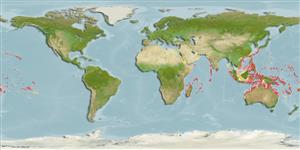Actinopterygii (ray-finned fishes) >
Perciformes (Perch-likes) >
Labridae (Wrasses) > Corinae
Etymology: Halichoeres: Greek, als, alis = salt + Greek, choiros = pig (Ref. 45335).
Environment / Climate / Range
Ecology
Marine; reef-associated; depth range 1 - 30 m (Ref. 1602), usually 1 - 30 m (Ref. 27115). Tropical; 24°C - 28°C (Ref. 27115), preferred ?; 32°N - 28°S, 34°E - 134°W
Indo-Pacific: Red Sea south to Sodwana Bay, South Africa and east to the Line, Marquesas and Tuamoto islands, north to southern Japan, south to the southern Great Barrier Reef.
Length at first maturity / Size / Weight / Age
Maturity: Lm 12.8 range ? - ? cm
Max length : 27.0 cm TL male/unsexed; (Ref. 2334)
Dorsal
spines
(total): 9;
Dorsal
soft rays
(total): 11;
Anal
spines: 3;
Anal
soft rays: 11. Some geographical variations between Indian and Pacific Ocean and Red Sea. Adults with one or two yellow saddles over the back and sometimes with small black spot on upper peduncle. Small juveniles black and white, gradually changing with growth to adult pattern (Ref. 48636).
Inhabits sand patches of lagoon and seaward reefs to at least 30 m (Ref. 1602); also on slopes to moderate depths along drop-offs (Ref. 48636). Juveniles common at the bottom of surge channels (Ref. 9710). Feeds mainly on hard-shelled prey, including mollusks, crustaceans and sea urchins (9823).
Life cycle and mating behavior
Maturity | Reproduction | Spawning | Eggs | Fecundity | Larvae
Distinct pairing during breeding (Ref. 205).
Randall, J.E., G.R. Allen and R.C. Steene, 1990. Fishes of the Great Barrier Reef and Coral Sea. University of Hawaii Press, Honolulu, Hawaii. 506 p. (Ref. 2334)
IUCN Red List Status (Ref. 115185)
CITES (Ref. 94142)
Not Evaluated
Threat to humans
Harmless
Human uses
Fisheries: minor commercial; aquarium: commercial
More information
ReferencesAquacultureAquaculture profileStrainsGeneticsAllele frequenciesHeritabilityDiseasesProcessingMass conversion
Tools
Special reports
Download XML
Internet sources
